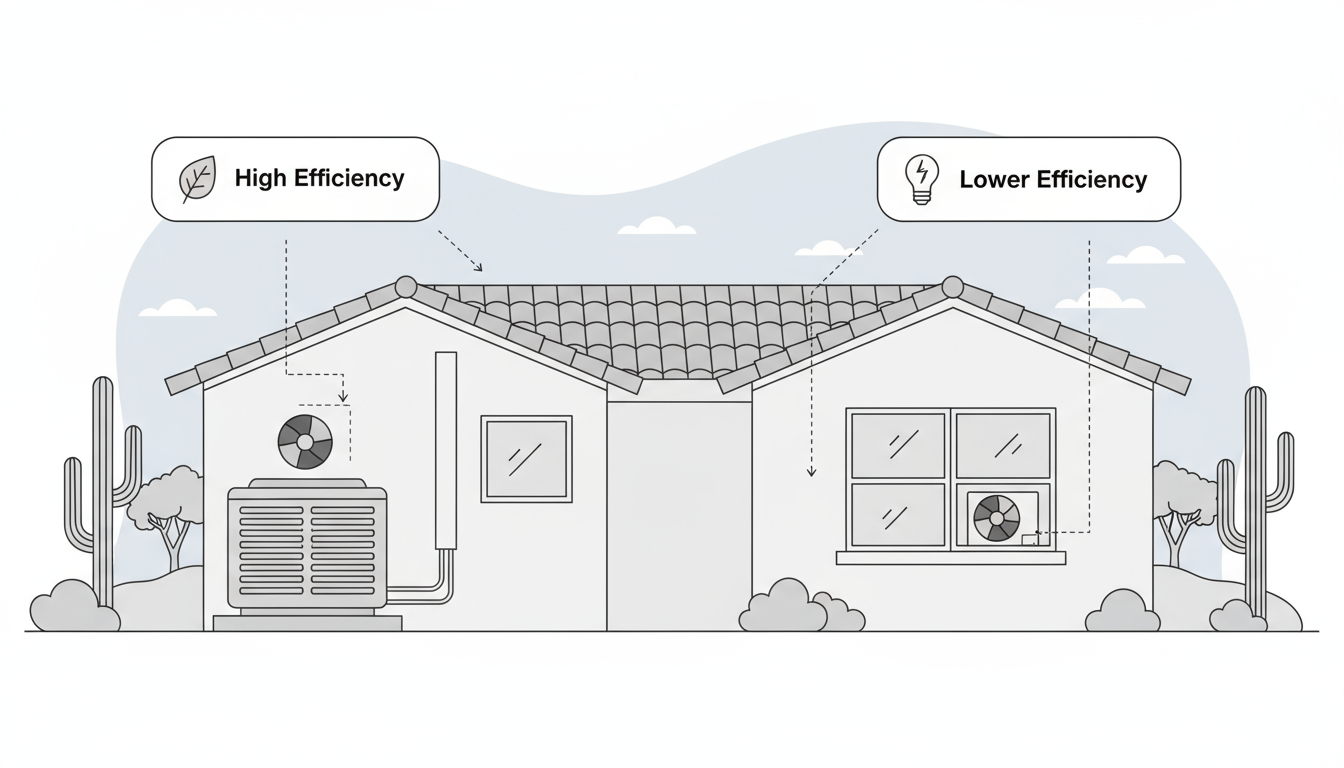

Arizona’s scorching summers, with temperatures often exceeding 100°F, make reliable cooling essential for comfort and health in homes across Phoenix, Tucson, and surrounding areas. Choosing between central air conditioning and window units involves weighing factors like efficiency, cost, and suitability for the state’s dry, dusty climate, where consistent cooling prevents heat-related issues. This guide compares both options to help homeowners decide which system best solves cooling challenges while optimizing energy use and long-term savings.
What Is Central Air Conditioning?
Central air conditioning systems use a network of ducts to distribute cooled air throughout the entire home from a central unit, typically including an outdoor condenser and indoor evaporator coil. In Arizona, these systems pair well with existing ductwork in most homes, providing uniform cooling that combats the intense heat without hot spots. They often integrate with furnaces for year-round climate control, making them a comprehensive solution for desert living.
Central AC excels in filtering out Arizona’s pervasive dust and allergens through high-efficiency filters, improving indoor air quality for residents with respiratory concerns. The system’s outdoor components handle the heavy heat load quietly, avoiding indoor noise disruptions during peak summer evenings. Homeowners appreciate how central systems maintain balanced humidity levels in dry conditions, preventing skin irritation and static buildup common in the region.
Pros and Cons of Central Air for Arizona Homes
One major advantage of central air in Arizona is its ability to cool the whole house evenly, eliminating the discomfort of varying room temperatures during prolonged heatwaves. High-efficiency models with SEER ratings above 16 reduce energy bills in a state where air conditioning accounts for up to 70% of summer electricity use, offering long-term savings on utility costs. Additionally, these systems enhance home value and appeal, as they provide a seamless, professional cooling setup ideal for larger Arizona properties.
However, the high initial installation cost, ranging from $3,000 to $8,000 or more, can deter budget-conscious homeowners, especially if ductwork needs repairs in older homes. Maintenance requires professional servicing to prevent dust accumulation in ducts, which could reduce efficiency and lead to higher repair bills averaging $300-$500 annually. While durable with a 10-15 year lifespan, central AC demands space for outdoor units, potentially clashing with aesthetic preferences in compact urban lots.
Understanding Window Air Conditioning Units
Window AC units are compact, self-contained systems installed directly into a window frame, using a single unit to cool one specific room by drawing in warm air and expelling heat outside. In Arizona rentals or small apartments, these portable options offer quick relief from afternoon heat without major modifications, plugging into standard outlets for immediate use. They come in various sizes, measured in BTUs, to match room dimensions, ensuring targeted cooling for bedrooms or home offices.
Modern window units feature inverter technology for variable-speed operation, adapting to Arizona’s fluctuating daytime highs and cooler nights to minimize energy spikes. Easy removal allows seasonal storage, preventing theft or damage during monsoons, a practical perk for transient residents. These units also often include dehumidification modes, though less effective in Arizona’s arid environment compared to central systems.
Pros and Cons of Window Units in Arizona
Window units shine with their low upfront cost of $150 to $800 per unit, making them accessible for cooling individual spaces like a sweltering kitchen during Arizona’s triple-digit days. Their simple plug-and-play installation empowers DIY setups, solving urgent cooling needs without waiting for contractors in busy summers. For single-room applications, they consume less power—around 500-1,500 watts—potentially lowering bills when used sparingly in energy-conscious households.
On the downside, multiple window units for whole-home cooling become inefficient and costly, often exceeding central AC expenses due to uneven distribution and higher per-unit energy draw in Arizona’s relentless heat. Noise levels from indoor fans and compressors can reach 50-60 decibels, disrupting sleep or work in quiet desert nights, while poor sealing around windows invites dust infiltration. Security risks arise from ground-floor installations, as units can be pried out, and they block window access, limiting natural ventilation options.
Cost Comparison: Upfront and Ongoing Expenses
Central air systems carry a steeper initial price tag of $3,000-$8,000, including professional duct integration and electrical upgrades often needed in Arizona homes built before modern efficiency standards. Window units, at $150-$800 each, plus minimal installation, appeal to those avoiding large investments, but outfitting a multi-room home could total $1,000-$3,000 with added brackets and seals. Factoring in Arizona’s average electricity rate of 13-15 cents per kWh, central AC’s efficiency yields lower monthly costs over time, potentially saving $200-500 annually compared to multiple window units.
Long-term, central AC repairs average $150-500 per incident, but preventive maintenance extends lifespan and avoids breakdowns during peak heat. Window units, while cheaper to fix at $50-200, require frequent replacements every 5-10 years, accumulating costs in high-use Arizona scenarios. Homeowners should calculate total ownership costs, including rebates for ENERGY STAR central systems up to $600 via federal incentives, to gauge true value.
Energy Efficiency in Arizona’s Hot, Dry Climate
In Arizona’s extreme heat, central AC systems outperform with SEER 2 ratings of 14-20, circulating air efficiently through insulated ducts to combat solar gain and maintain 75-78°F indoors without strain. Window units achieve CEER ratings of 10-15, suitable for spot cooling but prone to 20-30% energy loss from poor insulation around frames in dusty conditions. Pairing central AC with smart thermostats optimizes runtime, reducing consumption by 10-15% during off-peak hours when Arizona nights dip below 80°F.
Window units’ smaller compressors handle dry air well but struggle with whole-home demands, leading to overuse and higher peaks—up to 1,500 watts per unit versus central’s balanced 3,500 watts load. For Arizona’s long cooling season (6-8 months), central systems integrate better with ceiling fans and shading, enhancing overall efficiency and qualifying for APS or SRP utility rebates. Choosing high-efficiency models in either category minimizes environmental impact, aligning with Arizona’s push for sustainable energy amid rising temperatures.
Installation and Maintenance Considerations
Installing central AC requires licensed HVAC professionals to assess duct integrity and electrical capacity, a process taking 1-3 days but ensuring code compliance in Arizona’s strict building regulations. Window units install in minutes via adjustable frames, ideal for renters, but improper sealing can cause vibrations or leaks, exacerbating dust entry. Annual maintenance for central systems involves filter changes and coil cleaning to sustain 95% efficiency, while window units need monthly filter rinses to prevent mold in humid micro-environments.
In Arizona, dust storms demand frequent duct cleaning for central AC—every 1-2 years at $300-500—to avoid airflow restrictions, a less intensive task for window units cleaned quarterly. Both benefit from surge protectors against monsoonal power fluctuations, but central systems’ complexity justifies warranties from reputable installers. Proper upkeep solves common problems like reduced cooling output, ensuring reliability when temperatures soar.
Factors to Consider for Your Arizona Home
Home size dictates choice: central AC suits 1,500+ square foot homes for uniform cooling, while window units fit studios or additions under 500 square feet. Ownership status matters—homeowners invest in central for equity gains, renters opt for portable window solutions to avoid lease violations. Arizona’s climate favors central for allergy sufferers due to superior filtration, but window units work for budget setups with strategic placement near high-traffic areas.
Lifestyle influences decisions: families needing quiet, even cooling prefer central, while remote workers might use window units for zoned efficiency. Consult load calculations (20 BTUs per square foot) to size systems accurately, preventing overworking and inefficiency. Ultimately, hybrid approaches—central for main areas, windows for garages—balance costs in varied Arizona layouts.
Making the Right Choice for Comfort and Savings
For most Arizona homeowners seeking reliable, whole-home relief from brutal summers, central air conditioning emerges as the superior long-term investment due to its efficiency, air quality benefits, and even cooling. Window units provide a practical, affordable entry point for smaller spaces or temporary needs, solving immediate heat issues without commitment. Evaluate your home’s layout, budget, and usage to select the system that aligns with Arizona’s demanding climate, prioritizing energy-efficient models for sustainable comfort.
When you’re ready to upgrade your cooling system, contact the experts at Emergency Master Plumbing & Air for professional installation and maintenance tailored to Arizona homes. Reach them at 623-584-4706 to schedule a free consultation and ensure your space stays cool year-round.
